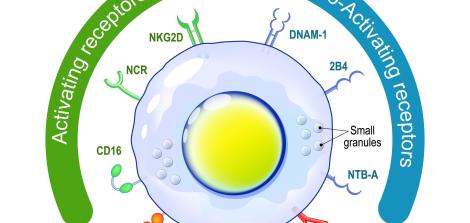RNA-Based Therapies for Infectious Diseases: A Genetic Mechanism in the Trypanosoma Parasite May Play a Key Role

The trypanosoma brucei parasite has been extensively studied in recent decades. This isn’t just because it causes African trypanosomiasis or sleeping sickness, which can be fatal for humans and cattle, but also because it can be easily cultured and genetically manipulated in the laboratory. However, despite these multiple studies, the genetic mechanisms of this parasite have not yet been fully exposed. A groundbreaking study conducted at the Mina and Everard Goodman Faculty of Life Sciences at Bar-Ilan University and led by Prof. Shulamit Michaeli has successfully uncovered a genetic mechanism that has the potential to be useful in developing new treatments for sleeping sickness and other infectious diseases.
Two hosts, one parasite - the trypanosoma parasite
During its lifetime, the trypanosoma parasite passes between two hosts – an insect and a mammal, altering its shape and its functions accordingly. In a mammal, the parasite lives in the bloodstream, where it reproduces and spreads. After exploiting the mammalian host's bodily resources almost in their entirety, this parasite’s circulation density rises to a critical threshold that could be fatal for the host, and it begins a process of transformation and adaptation prior to transferring to another host - the blood-sucking Tsetse fly. When the Tsetse fly sucks blood from a mammal hosting parasites in this state, the parasites pass into the Tsetse fly's intestine, where they exhibit several forms while adapting to their new host. As the fly's resources dwindle, the parasites travel from the intestine to its salivary glands, maturing into a form capable of infecting a mammal. And so, when the fly bites another mammal, the parasites transfer into its bloodstream and infect the mammal, repeating the cycle.
The DNA and RNA mechanisms of the trypanosoma parasite are studied by scientists for various reasons - one of which is to better understand its unique transformation processes. Understanding these mechanisms may help with developing treatments against African sleeping sickness and similar infectious diseases such as Chagas disease and Jericho Buttons disease (leishmaniasis), which are caused by parasites of the same family. Furthermore, as has happened several times in the past, the research of the trypanosoma parasite may also reveal more general heredity and biological processes and mechanisms that are also shared by other organisms.
The trypanosoma’s vulnerability: the shift from a mammal to an insect
As mentioned, during its lifetime this parasite cycles between an insect host and a mammalian host, over and over again. In its mammalian host, the parasite exhibits two secondary developmental forms: slender (active) and stumpy (dormant).
The slender form means the parasite is active and spreads and reproduces in the mammal's bloodstream, eluding the mammal's immune system. When the parasite reaches critical density, its density-sensing mechanisms detect this and signal it to transition into the stumpy "dormant" form. As a result of transitioning into this form, its population in the blood of the mammalian host stops growing,, increasing the mammalian host’s chances of survival. This allows the parasite to survive long enough to attempt to transfer to the next host – the Tsetse fly.
This process of changing that causes the parasite to become dormant has been identified by scientists as the parasite's point of vulnerability. If is is targeted by medical intervention, this may reduce the parasite's ability to reproduce in the mammalian body. To uncover these processes, the researchers focused on mapping a particular class of RNA molecules involved in the parasite's genetic regulation processes, known as 'long non-coding RNA’ (i.e. RNA molecules not involved in the coding process – the production of proteins according to the genetic code). This mapping process can provide additional information about the way the parasite controls its transition into a dormant form.
“Grumpy” RNA: The regulator responsible for the change in the parasite’s form
In order to map and reveal long non-coded RNA molecules and their functions in the trypanosoma parasite, the researchers used RNA sequencing methods, computer analyses, and integration of sequencing data in existing databases.
This way, the researchers identified 1,428 long non-coding RNA molecules, compared to only 95 that had been identified prior to the study. After a unique screening process, the researchers identified within those 1,428 sequences 399 genes involved in the genetic control processes in the trypanosoma parasite. Of these genes, the researchers isolated a gene coding for a unique RNA sequence they named grumpy - a regulator of growth and stump formation.
Depth sequencing of the gene expressing the grumpy RNA was performed in trypanosoma parasites in their two mammalian forms: active and dormant. When the researchers examined the expression of ‘grumpy RNA' they discovered that in the two different forms, there were different expressions. Also, in its stumpy form – the activity of this gene increased. It turns out that grumpy RNA acts as the supervisor of the parasite’s development and its transition from an active form into a dormant form. Grumpy RNA does this by binding to two other RNA sequences that play a role in the production of proteins required for the transition into a "dormant" state. Thus, over-expression of the gene signals the parasite to transition into the dormant state.
From theory to practice: trials using cell cultures and laboratory animals
Next, the scientists sought to examine whether manipulating this mechanism would trigger the transition of the parasite into a stumpy dormant form even if its population density didn’t rise. They first tested this in cultures of trypanosoma cells in the laboratory. With the help of genetic engineering technologies, the researchers used manipulations to cause gene over expression, which did, in fact, lead to the parasite’s transition into a stumpy dormant form.
At the final stage, the researchers tested their findings in animal model trials – using laboratory mice.
The researchers infected laboratory mice with genetically engineered parasites to over express the gene responsible for the production of grumpy RNA. Another group of mice infected with non-manipulated parasites was used as the control group.
The mice infected with a parasite that had not been manipulated became increasingly ill and eventually died - as expected. However, the mice infected with a manipulated parasite with “grumpy” over-expression did not become ill or die as a result of infection. The scientists thus proved that using manipulation to elicit the "grumpy" over-expression caused the parasite to become dormant without an increase in population and thus could prevent the disease.
The researchers also examined whether this mechanism could be used to slow down disease progression in mice who had already developed the disease. For this purpose, the scientists caused "grumpy" over-expression in 4 mice infected 4 days earlier with the active parasite that had already begun to develop the disease. The results: The lifespan of 3 mice was significantly higher compared to mice that had not been manipulated, and one mouse was completely cured.
These mice model trials confirmed the researchers’ hypothesis based on the results of their cell culture trials: Parasites that had not been manipulated began to exhibit their stumpy dormant forms only under high-density conditions, whereas parasites that over expressed grumpy RNA began to exhibit the stumpy form even under low-density conditions.
In doing so, the researchers were able to prove that they had found the parasite's vulnerability – an RNA sequence that triggers the parasite's transition into a dormant state under high-density conditions. Utilizing this mechanism for genetic intervention causes the parasite to transition from its active harmful state into its dormant state, thereby reducing morbidity and significantly prolonging life expectancy.
The bottom line: A scientific breakthrough
In this groundbreaking study, the researchers identified a new molecular mechanism in the trypanosoma parasite, a discovery that opens up a new field for research and development of treatment strategies for sleeping sickness and other illnesses caused by viruses of the same family.
Furthermore, by investigating the "grumpy" mechanism, scientists documented for the first time in the history of science the functional mechanism of long non-coding RNA molecules in this parasite and showed how it affects the production of proteins related to the transition between different states of this parasite. Future studies will be able to explore whether this mechanism, which operates "behind the genetic scenes", is exclusive to trypanosoma or is a general mechanism shared by other organisms-which may have extensive implications not only in the realm of genetic research, but also in the fields of life sciences, biology, and medicine.
Last Updated Date : 13/03/2023








